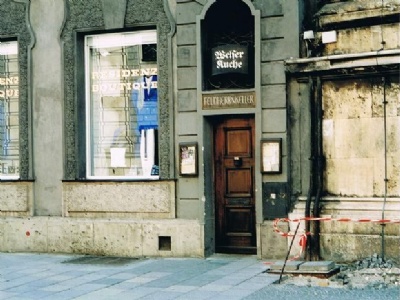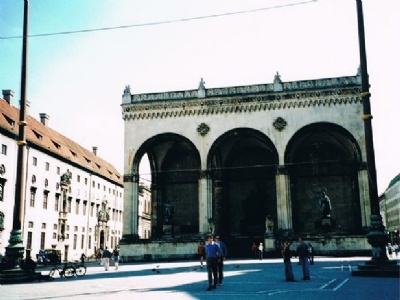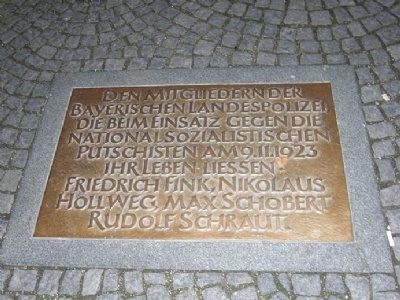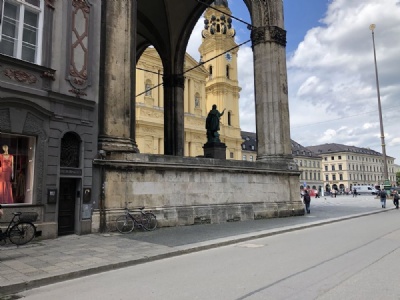München – Feldherrnkeller
It was at Feldherrnkeller (fieldmarshals hall) at Odeonsplatz, Munich, that the Nazi coup-makers clashed with Bavarian police forces on the morning of 9 November 1923. The clash had been preceded by Hitler’s coup attempt the night before. When the coup-makers realized that the coup was about to fail, about 2,000 coup participants marched out on the streets of Munich. At Feldherrnkeller they were stopped by Bavarian police and a shooting occured. Four policemen and sixteen coup participants were killed. Hitler and Hermann Goering were injured. Goering fled Germany while Hitler was tried and sentenced to prison in Landsberg Fortress. Between 1933 and 1944, ”Old fighters” gathered in the Bürgerbräukeller where the coup had begun. There, Hitler gave a speech and then conducted a ceremonial march along the same path that the coup participants had taken in November 1923. The march ended at Feldherrnkeller, Odeonplatz, where the coup attempt was knocked down. Here Hitler laid down a wreath at the memorial he had erected after the takeover of power in 1933. Between 1933 and 1944, the monument was guarded by an honorary guard and passers-by were expected to do the Hitler salute. But there were those who did not want to salute and they took a side-street named Vicardasse and thus avoid the monument.
Current status: Preserved with memorial tablet (2018).
Address: Odeonsplatz, 80539 München.
Get there: Metro to Odeonsplatz Station.
Follow up in books: Kershaw, Ian: Hitler – A Biography (2008).






After the war, the Nazi monument was removed. A few decades later a memorial plaque was set up in front of Odeonsplatz in memory of the four policemen killed during the clash with the Nazi coup-makers. The tablet was first on the ground, perhaps right where they died, but it is now replaced by a tablet on the facade roughly opposite Feldherrnkeller. This one also bears the names of the four policemen who were killed. Since 2013 there is also a monument in the street on Vicardigasse in memory of those who took the detour via Vicardigasse. This monument consists of bronze-coloured paving stones that meander about 18 metres along the street.
The swastika flag carried during the coup attempt received a quasi-religious status that can be equated with the holy grail. The flag was called by the Nazis, Blutfahne (Blood flag), cause it was stained with blood from the clash with the police. It was used in ceremonies to link new flags with the glory the blood flag had according to Nazi mythology. This flag had a honorary place in the Brown house next to Königsplatz, but disappeared in the final days of the war.
Most likely it was destroyed in connection with the bombing of Munich, in which the Brown House was almost completely destroyed. But, it may also be that it became a war souvenir and went back to the United States. Perhaps the one who possibly took it did not know its meaning, perhaps it is in some attic somewhere waiting to be discovered, perhaps, or perhaps relatives do not understand that the swastika flag stored away is in fact one of the holiest relics that existed in Hitler’s Third reich.